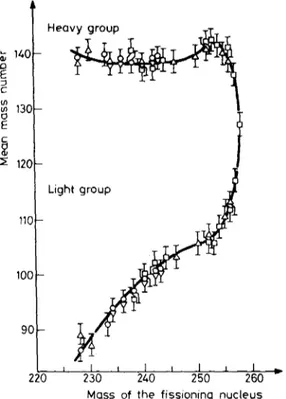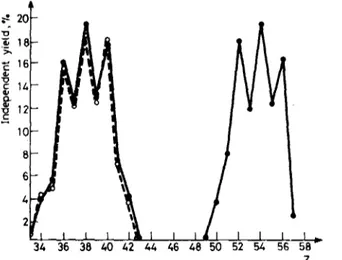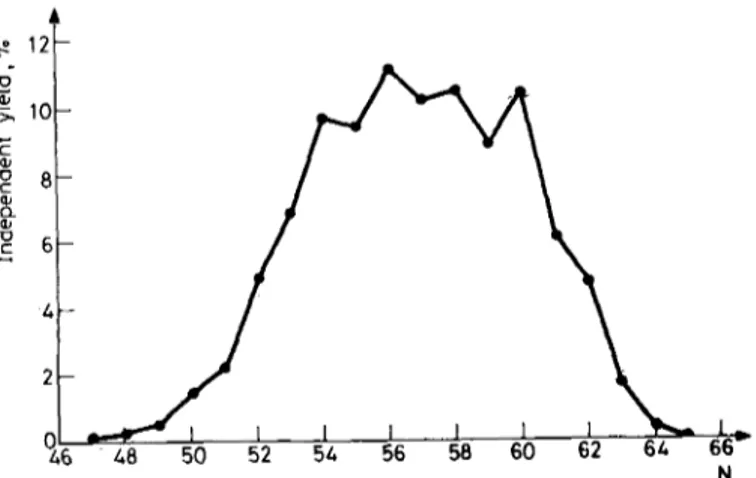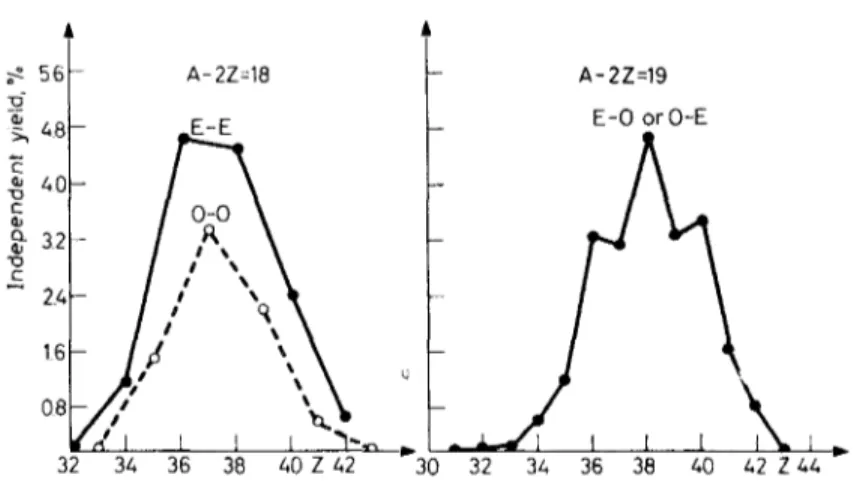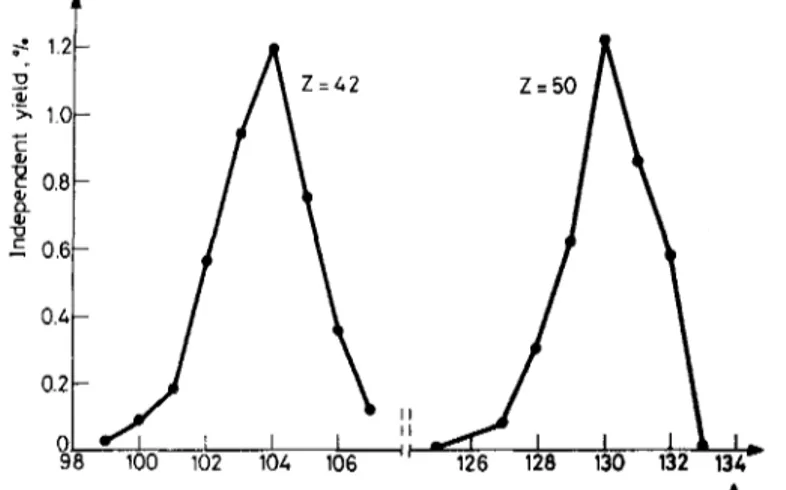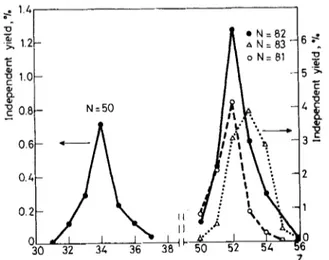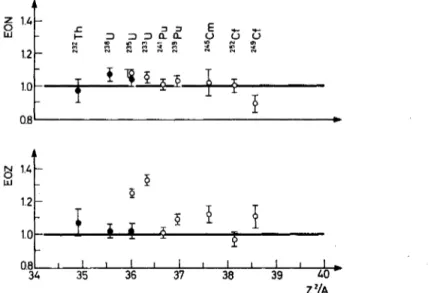Journal ofRadioanalytical and Nuclear Chemistry, Articles, Vol. 158, No. 1 [1992)41-52
FINE STRUCTURE OF MASS AND CHARGE DISTRIBUTION
IN LOW ENERGY FISSION
H. N. ERTEN,+ N. K. ARAS**
*Bilkent University, Ankara (Turkey] ~*Middle East Technical University, Ankara (Turkey]
(Received April 18, 1991)
Studies of finer details in mass and charge distribution in fission leads to a better under- standing of the fission process. Experimental determination of independent and cumulative yields using radiochemical techniques as well as mass spectrometers and fission product recoil separators form the basis of such studies. It has been established that closed shells as well as an even number of nucleons influence both mass and charge distributions. The magnitudes of these effects may be estimated from existing experimental yield data and various fission models. Using Our measurements of several fission yields and those existing in the literature we have calculated even-odd proton and neutron effects for various low energy fissioning systems. Where enough data existed, dkect calculations were made, whereas for other cases the Zp-model of WAHL has been used. It is found that the even-odd proton effect is Well established and pronounced in thermal neutron fission of 23 s U and ~ ~ 3 U. Lesser effects were found for reactor neutron induced fission of ~ 32Th ' thermal neutron fission of 239Pu and spontaneous fission of 245Cm and 2+9Cf. No effect seems to exist in the thermal neutron fission of 241 Pu and the spontaneous fission of 2 s 2 Cf. The even-odd neutron effect is found to be much lower than the corresponding proton effect in 23 s U and 233 U fissions and is nonexistent in the rest of the fissioning systems.
Introduction
Mass, charge and kinetic energy distributions in fission have been the subject o f extensive e x p e r i m e n t a l and t h e o r e t i c a l studies since the discovery o f fission fifty years ago. 1 R a d i o c h e m i c a l m e t h o d s have been primarily used for fission yield measure- m e n t s s u p p l e m e n t e d by mass-spectrometric and fission p r o d u c t recoil techniques. These m e a s u r e m e n t s , particularly those o f t h e i n d e p e n d e n t yields are difficult. As a result, an almost c o m p l e t e set o f e x p e r i m e n t a l i n d e p e n d e n t yield data exists for t h e t h e r m a l n e u t r o n fission o f 23 s U o n l y f o l l o w e d by 2 3 3 U and 23 9pu fissions. F o r the s p o n t a n e o u s fission o f 2 S 2 c r o n l y a b o u t 35% o f the i n d e p e n d e n t yields has been m e a s u r e d . On t h e o t h e r hand, mass distribution, w h i c h is characterized by chain yield m e a s u r e m e n t s , has been m u c h b e t t e r established t h a n charge distribution in l o w
Elsevier Sequoia S. A., Lausanne A kacl dm iai K iad 6, Budapest
H. N. ERTEN, N. K. A R A S : FINE S T R U C T U R E OF MASS AND C H A R G F
energy fission. 2,3 Recently all available yield data in low energy fission were com- piled by WAHL. 2
We have also been measuring fission yields of several products in some low energy fissioning systems over the years. 4-9 The results of such studies together with recent compilations 2,10 have been used in reevaluating fine structure effects on the mass and charge distributions in low energy fission. AMIEL and FELDSTEIN 11 were the first to carry out a systematic stt:dy of the even-odd effect in the thermal neutron
fission of 2 3 s U and 2 3 3 U. This effect was further explored by many investigators. 2,10,12-14
Calculations
Average masses of light peak fission products have been calculated from the relation: A L CY(A)" A L all A L = ( 1 ) A L E CY(A) all
where CY(A) - yield of mass number A chain, AL - mass number of light products.
A similar expression was used for the heavy peak AH calculation. Tile even-odd effect, defined as the enhancement of independent fission yields of even Z and even N products relative to odd ones can be determined using the relation:
z 22; Ye(Z) all E O Z - ( 2 ) Z z 2; Ye(Z) + E Yo(Z) all all
where EOZ - even-odd proton enhancement factor,
Ye(Z) - isotopic independent yield of even Z products, Yo(Z) - isotopic independent yield of odd Z products.
A similar expression was used for evaluating the even-odd neutron enhancement factor EON.
In the case of low energy fissioning systems with enough yield data available, Eq. (2) gives the magnitude of EOZ or EON directly. For other systems, various charge distribution models may be used. We have used the Zp-model of WAHL 14 for such calculations.
H. N. ERTEN, N. K. ARAS: FINE STRUCTURE OF MASS AND CHARGE
Results and discussion
Figure
1 shows average post-neutron-emission masses o f fission products as a func- tion o f the mass o f the fissioning nucleous for various low energy fission processes calculated by Eq. (1). Data for the reactor neutron fission o f 232Th are from our work. 7 The rest o f the mass yields are from Refs 2, 1 6 - 1 8 . It is observed that the mean mass o f the heavy product group is nearly constant at about A = 140 for fissioning nuclides from Af = 230 to 246. The mean mass o f the light p r o d u c t group shows a steady increase with Af until about Af = 250. Beyond Af = 250 the average~, 14C
H
e
a
~
c ~E
130-
O @:~ 120 =
'
i
11C Light group
_- 2
10C
, ~ /
90- i l I l , I , I220
230
240
250
260
Mass of the fissioning nucleus
Fig. 1. Post-neutron-emission average masses as a function of mass o f the fissioning nucleus: thermal neutron induced fission, o reactor neutron induced fission, ~ spontaneous fission
mass o f the heavy group first rises, whereas that o f the light group somewhat flattens; afterwards the two groups rapidly converge and at Af = 258 we have symmetric fission. It is believed that the mass asymmetry in low energy fission, which trims into symmetric division with increasing Af, is influenced by the existence o f Z = 50 and
H. N. ERTEN, N. K. ARAS: FINE STRUCTURE OF MASS AND CHARGE
N = 82 proton and neutron closed shells in the heavy product group. However, it is not clear why the average heavy group mass stays constant at A = 140 and not at the double magic A = 132. The available nuclear models cannot fully explain the observed mass divisions in low energy fission and this still remains one o f the mysteries o f the fission process.
20 "r 18 '~, r 10
f,
I I i 1 I3Z, 36 38 40 42 44
46 48 50 52 54 56 58
I i /
i I
ZFig. 2. Elemental yield distribution in the thermal neutron fission of 23 s U: * radiochemical yields based on CHUNG's data, ~~ o LOHENGRIN data of CLERC et al. la
The independent yields of individual elements formed in the thermal neutron fission o f 23 + U are shown in Fig. 2. The yield data o f WAHL, 2 CHUNG 1 o and CLERC et al. 12 have been used. The first two are based on radiochemical measure- ments, whereas the third used fission product recoil techniques. The results of the two independent type o f measurements agree quite well although radiochemical measurements represent yields integrated over all kinetic energies of the products, whereas the LOHENGRIN measurements were made at the most probable kinetic energies. The charge asymmetry is very evident. It is interesting to observe that the distribution is narrow and only five elements in each of the light and heavy product groups are formed prominently; krypton to zirconium and tellurium to barium. Furthermore, yields o f the elements of even atomic numbers are enhanced relative to those with odd numbers.
The isotonic yields of the light product group based on data of CLERC et al. 12 are shown in Fig. 3. The distribution is much wider than the corresponding isotopic distribution and the even-odd neutron effect, EON is much smaller than the EOZ. Both results are probably due to the neutron evaporation process.
H, N. ERTEN, N. K. ARAS: FINE STRUCTURE OF MASS AND CHARGE i .-e. 1 2 - "o 9 ~ I 0 - 2 L~ 0 6 48 50 52 54 56 58 60 62 64 66- N
]Fig. 3. Isotonic yield distribution in the light group products in thermal neutron fission o f
~3sU, based on the data of CLERC et al. 12
(= E E - - 10 32 ,o
,,,3o
? XA
I I~
: . - P~ tI-,;~',
I
-,
. - _ _ ~,..& i l lt i b I l"~tvl I I I 1 "~i2,.i,-.4 34 36 38 40 42 44 46 40 50 52 54 56 58 60 Z 621"Fig. 4. Elemental yield distribution in the thermal neutron fission of 23 s U, 2 s 3 U, : a 9 Pu and the spontaneous fission of 2 ~ 2 Cf based on the X-ray measurements of REISDORF et al. a 9
R E I S D O R F et al. 19 c a r r i e d o u t a n e x t e n s i v e s t u d y o f n u c l e a r c h a r g e d i s t r i b u t i o n in t h e t h e r m a l n e u t r o n fission o f 2 3 S U ,
233U, 239ptl
a n d s p o n t a n e o u s fission o f 2 s 2 C f b y m e a s u r i n g K X - r a y yields o f t h e p r o d u c t s , Figure 4 is b a s e d o n t h e i r results. It is seen t h a t t h e m o s t p r o b a b l e c h a r g e o f t h e h e a v y p r o d u c t g r o u p is c o n s t a n t ,H. N. ERTEN, N. K. ARAS:FINE STRUCTURE OF MASS AND CHARGE & 56 ~,, 48 40 E 32 n o E 2A 16 08 32 A-2Z=18 34 36 38 40 Z 42 A 3O A-2Z=19 E-O or O-E • I 32 3/, 36 38 40 42 Z 44
Fig. 5. Independent yield of products with an even (E) or odd (O) number of protons and neutrons in the thermal neutron fission of 2 ~ s U for the light mass peak. Curves are for constant excess neutrons of products with most available fission yields
.4 7.2 ~, 6.4 5.6 g c 4.0 3.2 2.4 A-2Z=30 A-2Z=31 16 08 50 E-E O-O
o,,/ "a~
I I I L I 52 54 56 58 Z 60 50 52 54 56 5 8 Z 6 0 E-O or O-E [Fig. 6. ~ndependent yields of products with an even (E) or odd (0) number of protons and neutrons in the thermal neutron fission of 2 3 s U for the heavy mass peak. Curves are for constant excess neutrons of products with most available fission yields
w h e r e a s t h a t o f t h e l i g h t g r o u p m o v e s t o w a r d s t h e h e a v y g r o u p w i t h i n c r e a s i n g Af. T h i s b e h a v i o r is similar t o t h a t o f t h e average p r o d u c t m a s s e s as s h o w n in Figure 1. A n o t h e r i m p o r t a n t o b s e r v a t i o n f r o m F i g u r e 4 is t h a t , w i t h t h e p o s s i b l e e x c e p t i o n o f 233 U, n o s i g n i f i c a n t e v e n - o d d e f f e c t s s e e m t o exist.
A n a l t e r n a t i v e w a y o f i l l u s t r a t i n g a n d e s t i m a t i n g E O Z or E O N e f f e c t s is s h o w n in Figs 5 a n d 6. Here, i n d e p e n d e n t yields o f p r o d u c t s w i t h t h e same n e u t r o n excess
H. N. 1.;RTEN, N. K. ARAS: FINE STRUCTURE OF MASS AND CHARGE
values are p l o t t e d as a f u n c t i o n o f a t o m i c n u m b e r for light and heavy peaks respectively. The difference b e t w e e n even Z, even N ( E E ) and odd Z, o d d N ( O O ) yields are striking. F u r t h e r m o r e , in the heavy p e a k the possible effects o f Z = 50 N = 82 shells m a k e the EE curve m u c h higher than the OO curve. The EO and OE curves clearly reveal t h a t the p r o t o n pairing e f f e c t is m u c h higher than that o f n e u t r o n pairing.
A s u m m a r y o f yield data and the results o f E O Z and E O N calculations in the thermal n e u t r o n fission o f 2 3 s U, 2 3 3 U, 2 3 9pu and s p o n t a n e o u s fission o f 2 s 2 C f b y Eq. (2) are given in Table 1. The yield data are almost c o m p l e t e o n l y in t h e case
Table 1
Summary of independent yield data and results of EOZ, EON and specific yield calculations in the thermal neutron fission of ; 3 s U, 23 ~ U,
2 3 9 Pu and s p o r t a n e o u s f i s s i o n o f ~ s 2 C f Parameter examined 235 U 23 ~ U 2 ~ 9 Pu 25 ~ Cf Number Even Z products 103 84 73 37 Odd Z products 121 90 84 21 Even N products 99 88 74 47 Odd N products 125 86 83 11 YieM Even Z products 117.74 89.72 82.23 43.15 Odd Z products 73.15 60.43 69.30 28.89 Even N products 98.92 72,80 76.48 61.04 Odd N products 91.97 79.35 75.05 11.00 EOZ 1.23 1.20 1.08 EON 1.04 0.96 1.01
Specific yield: (~ Yield/l~ Nuclide)
Even Z products 1.14 1.07 1.13 - Odd Z products 0.60 0.67 0.83 - Even N products 1.00 0.83 1.03 - Odd N products 0.73 0.92 0.90 - (EOZ)sp 1.31 1.23 1.15 (EON)sp 1.16 0.95 1.07 Total yield Light peak 101.57 98.74 95.39 32.40 Heavy peak 89.32 51.41 56.14 39.65 Total 190.89 150.15 151.53 72.05 47
H. N. ERTEN, N. K. ARAS: FINE STRUCTURE OF MASS AND CHARGE
of 23 s U. Here, there is about 10% independent yield yet to be measured in the heavy mass peak. In the case o f 233U and 239pu fission the data o f the light mass peak region are almost complete, whereas about 50% o f yields o f the heavy peak are still lacking. For 2 s 2 Cf, which is the next most studied fission process, most of the experimental independent yield data is still missing. Thus for 2 s 2 Cf and all the rest
lO ~, 1.s
i
0.8 0.6 0.4 0 . 2 - 0 98 Z=42 = II Jl 100 102 104 106 126 128 130 132 134~ AFig. 7. Independent yield distribution o f Z = 50 and its complementary Z = 42 isotopes in the thermal neutron fission of 2 ~ s U
o f the low energy fissioning nuclides, no meaningful analysis o f EOZ and EON effects can be made using Eq. (2).
It is interesting that the number o f even Z and even N products with measured yields are appreciably less than the corresponding odd ones (Table 1). On the basis o f the pairing effect in nuclear structure, one would expect the opposite to be true, as in the case for example o f the number o f stable even and odd isotopes found in natu e, 212 versus 54, respectively. This reversal o f the expected behavior is probably caused by the Z = 50, N = 50 and N = 82 nuclear shells. The yields of products in the vicinity o f shells, are enhanced, while the number o f products formed is suppressed because o f preferential formation. Figures 7 and 8 illustrate the influence o f nuclear shells on the independent yields in the fission o f 23 s U. The effect of the Z = 50 proto n shell and its complementary Z = 42 is shown in Fig. 7. The yield distribution is narrow and symmetric. The corresponding influence o f N = 50 and N = 82 neutron shells is shown in Figure 8. The enhancement of yields and narrow symmetric distribution o f N = 82 isotones is apparent. The N = 50 effect is not as pronounced.
H. N. ERTEN, N. K. A R A S : FINE S T R U C T U R E OF MASS A N D C H A R G E
~4 14
t
-&
e. N=62
9 ~12
N=83 6
oN=81
10
5 ~"
06 ~ 3 1 ~
2 - -04
I]
."
94
38 II
50
52
I
54
5
Z
Fig. 8. I n d e p e n d e n t yield distribution o f N = 50 and N = 81, 82, 83 isotopes in the termal n e u t r o n fission o f 23 s U
14 ~
"6 z 86
0
%B 32
36
40
II
44 48 5256
60
Z
Fig. 9. Distribution o f the n u m b e r o f isotopes formed as a function o f atomic n u m b e r in the thermal n e u t r o n fission o f 23 s U
Figure 9 shows the distribution o f the number of isotopes formed in the fission o f 2 a s U as a function o f atomic number. Since the experimental measurement o f in- dependent yields is almost complete for 2 a s U fission, we assume that all the products with reasonably independent yields are included in this comparison. The striking feature of the isotopic distribution is the existence of fine structure peaks with
H. N. ERTEN, N. K. ARAS: FINE STRUCTURE OF MASS AND CHARGE
somewhat more prominence in the light peak region. The heavy region is considerably narrower, a clear effect of Z = 50, N = 82 shells. A comparison of this figure with the elemental yield distribution given in Figure 2 points to some similarities, namely, fine structure effects and also important differences. The number of odd Z isotopes are enhanced relative to even Z ones, an effect just the opposite o'f the yield enhancements of Figure 2. As was pointed above, this observed reversal is due to the influence of nuclear shells. Thus it appears that what is calculated as EOZ or EON from Eq. (2), also contains contributions from nuclear shells effects. From such considerations we have defined and computed specific yield per nuclide (~ Yield/~ Nuclide) values for products with even and odd numbers of protons and neutrons as shown in Table 1. It is seen that the specific yields of even Z products are significantly above unity and those of odd Z products considerably below unity.
The results of even-odd yield enhancement factor calculations EOZ and EON using Eq. (2), in the thermal neutron fission of 23Su, 233U and 239pu are given in Table 1. The available yield data of 2 s 2 Cf fission were not sufficient for such treatment. The EOZ values are pronounced only for 233 U and 23 s U fission, whereas the EON values are very close to unity, indicating no effect. On the other hand, if the specific yields defined above are used in Eq. (2), the even-odd enhancement factors, (EOZ)s p and (EON)sp come out somewhat higher than those using independent yields (Table 1). The increased values may be attributed to the influence of nuclear shells. From such calculations we estimate about 7% yield enhancement due to shell effects, the rest being due to true pairing. This estimated magnitude of the shell effect contribution to the even-odd effect is obtained considering all the fission products in all regions; a sort of average contribution. If one takes into account, however, that the shell effects are most pronounced at the shell regions and their complementaries only, then the magnitude of the shell effects should increase con- siderably within these regions and would be negligible outside. These findings are in line with those of CLERC et al. 12 who found shell effect modulations in EOZ and EON values for the light peak products and the observations of WAHL ~~ in the symmetric region where no even-odd and/or shell effects were found.
The above treatment is only possible with a complete set of yield data and since this is lacking for most of the low energy fissioning systems, one may use various models of charge distribution to estimate the even-odd effect. The Zp model of WAHL 2 is the most widely accepted and used model for this purpose. Using the available experimental yield data and the method of least squares, one obtains para- meters of charge distribution for individual isobaric mass chains as well as for the whole fissioning nuclide. We have carried out such charge distribution calculations using the Zp-model for several low energy fissioning systems. The even-odd proton and neutron enhancement factor results are shown in Fig. 10. The EOZ effect is well 50
H. N. ERTEN, N. K. ARAS: FINE STRUCTURE OF MASS AND CHARGE established and prominent in 23 s U and ~ 33 U fissions only. In the fission o f 232 Th, 239pu, 24SCm and 2 4 9 C f t h e EOZ effect is o f the order o f the estimated shell effect.
In the rest o f the fissioning systems it is not significantly different from 1.0. The EON effects are found to be small in all cases and somewhat larger than 1.0 for 233 U and 23 s U fissions only.
z 1.4 0 h i 1.2 1.0 0.8 I.- "~ "~ :D ~. t~ t..) tA t,.) 1.4 1.2 1.C 0181 34 i 35 I ] 36 I I 37 I I 38 I , 39 I i 40 I
zyA
Fig. 10. Comparison of EOZ and EON values for various low energy fission processes calculated according to the Zp-model of WAHL. 2 The experimental yields used in the calculations are from References; 2 ,t o ~i 5,21-24 9 fast neutron fission, o thermal neutron and spontaneous fission
A comparison with the results o f Table 1 show that model calculations generally overestimate the even-odd effects. In the most extreme case o f 233 U this overestimation is about 10%. These findings suggest that the even-odd effects in low energy fission should be taken into account with caution and such corrections should not be applied to all products. Apart from 23 s U and possibly 23 a U and 2 a 9pu fission, experimental data to enable the t y p e o f direct analysis as given in Table 1 are lacking.
More experimental yield measurements and model calculations are certainly needed in order tO clarify, understand and quantify these important fine structure effects in low energy fission.
H. N. ERTEN, N. K. ARAS: FINE STRUCTURE OF MASS AND CHARGE
References
1. O. HAHN, F. STRASSMANN, Z. Naturwiss., 27 (1939) 11. 2. A. C. WAHL, Atomic Data and Nuclear Data Tables, Vol. 39, 1988. 3. C. D. CORYELL, M. KAPLAN, R. D. FINK, Can. J. Chem., 39 (1951) 646.
4. H. GOKTIARK, O. BIRGt3L, H. N. ERTEN, N. K. ARAS, J. Inorg. Nucl. Chem., 37 (1975) 2247. 5. H. N. ERTEN, O. BIRGtAL, N. K. ARAS, J. Inorg. Nucl. Chem., 40 (1978) 183.
6. H. N. ERTEN, N. K. ARAS, J. Inorg. Nucl. Chem., 41 (1979) 149.
7. H. N. ERTEN, A. GRIJTTER, E. ROSSLER, H. R. VON GUNTEN, Nucl. Sei. Eng., 79(1981) 167.
8. H. N. ERTEN, A. GRIJTTER, E. Rt)SSLER, H. R. VON GUNTEN, Phys. Rev. C., 25 (1982) 2519.
9. L. TOPPARE, H. N. ERTEN, N. K. ARAS, Can. J. Chem., 61 (1983) 649. 10. C. CHUNG, Radiochim. Acta., 39 (1986) 113.
11. S. AMIEL, H. FELDSTEIN, Phys. Rev. C., 11 (1975) 845.
12. H. G. CLERC, W. LANG, H. WOHLFARTH, K. H. SCHMIDT, H. SCHRADER, K. E. PHER- DEKAMPER, R. JUNGMAN, Z. Phys., A274 (1975) 203.
13. G. MARIOLOPOULOS, Ch. HAMELIN, J. BLACHOT, J. P. BOCQUET, R. BRISSOT, J. CRANSON, H. NIFENECKER, Ch. RISTORI, Nucl. Phys. A361 (1981) 213.
14.,D. R. SAROHA, R. K. GUPTA, Phys. Rev. C., 29 (1984) 1101. 15. A. C. WAHL, J. Radioanal. Chem., 55 (1980) 111.
16. B. F. RIDER, NEDO-12154, 1980.
17. D. C. HOFFMAN, M. M. HOFFMAN, Ann. Rev. Nucl. Sci., 24 (1974) 24.
18. D. C. HOFFMAN, Physics and Chemistry of Fission, Vol. 2, IAEA, Vienna, 1980, p. 275. 19. W. REISDORF, J. P. UNIK, H. C. GRIFFIN, L. E. GLENDENIN, Nucl. Phys. A, 177 (1971)
337.
20. A. C. WAHL, Phys. Rev. C, 32 (1985) 184.
21. R. BRISSOT, J. CANSON, Ch. RISTORI, J. BOCOUET, A. MOUSSA, Nucl. Phys. A, 282 (1977) 109.
22. H. R. VON GUNTEN, K. F. FLYNN, L. E. GLENDENIN, Phys. Rev., 161 (1967) 1192. 23. J. K. DICKENS, J. W. CONNELL, Phys. Rev. C, 23 (1981) 331.
24. H. H. MAIXLER, Ph D. Tesis, Nuclear Chemistry Institute, University of Mainz, 1980.
